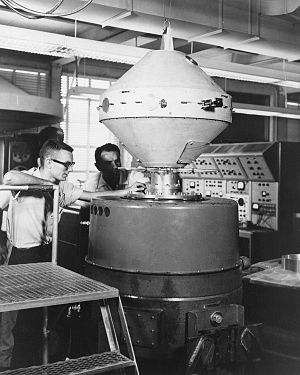 Explorer 8 satellite | |
| Names | S-30 NASA-S30 |
|---|---|
| Mission type | Earth science |
| Operator | NASA |
| Harvard designation | 1960 Xi 1 |
| COSPAR ID | 1960-014A |
| SATCAT no. | 00060 |
| Mission duration | 54 days (achieved) |
| Spacecraft properties | |
| Spacecraft | Explorer VIII |
| Spacecraft type | Science Explorer |
| Bus | S-30 |
| Manufacturer | Jet Propulsion Laboratory |
| Launch mass | 40.88 kg (90.1 lb) |
| Dimensions | 76 × 76 cm (30 × 30 in) |
| Power | 100 watts |
| Start of mission | |
| Launch date | 3 November 1960, 05:23:10 GMT |
| Rocket | Juno II (AM-19D) |
| Launch site | Cape Canaveral, LC-26B |
| Contractor | Army Ballistic Missile Agency |
| Entered service | 3 November 1960 |
| End of mission | |
| Last contact | 27 December 1960 |
| Decay date | 28 March 2012 |
| Orbital parameters | |
| Reference system | Geocentric orbit[1] |
| Regime | Medium Earth orbit |
| Perigee altitude | 416 km (258 mi) |
| Apogee altitude | 2,286 km (1,420 mi) |
| Inclination | 49.9° |
| Period | 112.7 minutes |
| Instruments | |
| Electric Field Meter Ion Traps Langmuir Probe Micrometeorite Microphone Micrometeorite Photomultiplier RF Impedance Satellite Drag Atmospheric Density | |
Explorer program | |
Explorer 8 was a NASA research satellite launched on 3 November 1960.[2] It was intended to study the temporal and spatial distribution of the electron density, the electron temperature, the ion concentration, the ion mass, the micrometeorite distribution, and the micrometeorite mass in the ionosphere at altitudes between 400 km (250 mi) and 1,600 km (990 mi) and their variation from full sunlit conditions to full shadow, or nighttime, conditions.[3]
- ^ McDowell, Jonathan (9 September 2021). "Satellite Catalog". Jonathan's Space Report. Retrieved 3 November 2021.
- ^ "Explorers: Searching the Universe Forty Years Later". NASA Fact Sheets. NASA. Archived from the original on 11 May 2008. Retrieved 3 February 2008.
 This article incorporates text from this source, which is in the public domain.
This article incorporates text from this source, which is in the public domain.
- ^ Cite error: The named reference
Displaywas invoked but never defined (see the help page).